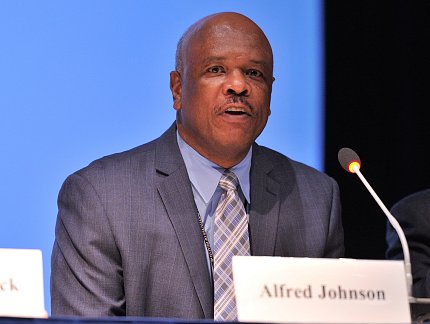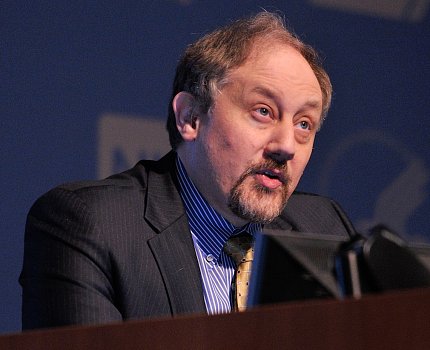NIH Community Drives ‘Optimize NIH’ Improvements

Photo: Marleen Van Den Neste
Twenty-seven institutes and centers make up NIH, giving the agency the ability to conduct and support a variety of promising avenues of scientific research. Still, there may be room for improvement, explained NIH principal deputy director Dr. Lawrence Tabak.
“What ReImagine HHS and, in turn, Optimize NIH have been about is identifying areas that we can enhance and improve by working together,” he said at a Mar. 4 town hall meeting on Optimize NIH in Masur Auditorium.
Optimize NIH is part of ReImagine HHS, an effort to improve efficiency and effectiveness within the department, said Charles Keckler, an associate deputy secretary at HHS. ReImagine HHS includes 6 strategic shifts with 10 initiatives. Each one focuses on improving programs and rethinking how HHS serves the American people.
“Optimize NIH is special in a number of ways,” Keckler said. “It represents a pilot model for how ReImagine principles can cascade down to the [operating] division level.”
Tabak noted that the Optimize NIH team first focused on committee management, ethics and Freedom of Information Act functions. Subject matter experts identified what could be improved, studied best practices and made recommendations. They designed strategic plan templates and developed metrics and standards that can be used NIH-wide.

Staff have made “extraordinary” progress since the start, he said. The FOIA group built a platform called FOIAXpress, which allows users to share documents and track the progress and timelines of requests. The committee management group reduced the cost and time it takes to process nomination slates and committee appointments and improved the onboarding process for members. The ethics group decreased the number of steps employees must take and forms they must fill out across all ICs.
For the next phase, staff worked with leaders of Optimize NIH to develop criteria for identifying other areas that could be improved, said Dr. Alfred Johnson, NIH deputy director for management. They used what they learned from the first phase.
Together, they came up with five new areas to examine. These include acquisitions, IT security, processes for attracting and retaining senior staff with outstanding scientific, technical and clinical skills under a flexible mechanism called Title 42, travel and property.
The first three areas must be harmonized “across the entire agency,” Tabak said. The remaining two areas, travel and property, “lend themselves to doing experiments” to figure out the best practices and develop tools.
Tabak thanked the many staffers who have volunteered time from their busy schedules and their expertise.
NIH’ers can watch the whole town hall online at https://videocast.nih.gov/summary.asp?Live=31562&bhcp=1. Also, an intranet site devoted to the effort is updated regularly at http://employees.nih.gov/pages/optimize-nih.aspx.
